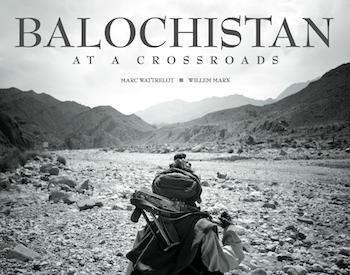|
|
The South
Asian Life & Times - SALT |
|
|||
|
Contents Feature Heritage People
Book Reviews Kaavad
Traditions of Rajasthan
- exploring
|
|
||||
|
Balochistan
Balochistan At a Crossroads
is a powerful blend of eloquent narrative and compelling images. The book is
both a travelogue and an adventure story with spectacular black-and-white
images that capture the spirit of Balochistan. Marx and Wattrelot offer a
rare insight into an area of which little is known and one that has become
one of the most dangerous on earth - one has escaped attention all these
years. Balochistan, the largest province of Pakistan – with
only 5% of its population is blessed with great reserves of natural
resources – natural gas (supplies to most of Pakistan’s needs), iron ore,
and mineral wealth. But it is also a known drug trafficking route, and a
land of insurgency, where hundreds of people have disappeared. The Baloch
story has had very little international coverage - because it is a difficult
and dangerous place to report from. Willem Marx (a journalist) and Marc
Wattrelot (a photographer), are perhaps the two rare journalists who managed
to travel extensively within the province, at times having to encounter the
wrath of government authorities. Balochistan, despite its natural wealth, has
remained a poor province with the worst literacy and health statistics in
the country. This has led to alienation of the Baloch people who feel
“increasingly distant from the central government.” There have been several
insurgencies in the past, led primarily by BLA – Baloch Liberation Army. In
the past their targets were army establishments but of late they have been
attacking civilians – the recent attacks on a train and on Hazaras received
very negative press. The Baloch, as an ethnic group, are spread over three
countries – Pakistan, Iran, and Afghanistan.
The book is an account of their travel in the
province - along the stunning Makran coast, to the port of Gwadar, to the
ship-breaking centre at Gadani,
to
the fishing villages,
to
the tribal fiefdoms of the desert – and driving on the new highway
considered the “bright new hope of the region.”
Gwadar
port city, people were told, would be made Dubai like – a city rising from
the sands. The authors saw a ship or two – and that was all. The Chinese
built Gwadar, Singaporeans run it - despite the heavy investment, it remains
a white elephant.
The locals, happy to see them, invited them to their
homes, and extended their legendary hospitality, shared whatever food they
had. They stayed with local people, not in hotels in order to avoid
intelligence agencies. They relate their chance meetings and conversations
with struggling fishermen, young activists, regular folk, and government
agents to walk the reader through the region's political, ethnic and
economic history, which explains the present-day conflict. “So much in
Balochistan is reminiscent of a fascinating past, but it is when you meet
the people here — few though they are amid the vast majesty of the landscape
— that you realize it is the future to which they are all looking, often
with trepidation.” The land, according to the authors, is blessed with
unparalleled and striking landscape but there is nobody to view it or enjoy
it - “possessed of more than five hundred miles of beautiful coastline, with
mangrove swamps, dolphin reserves, golden sands and sheer limestone cliffs
among its fabled attractions.” Quetta is a beautiful city ringed by
mountains. The book is a brilliant piece of journalism and
photo-journalism.
About the authors
Willem Marx, grew up in
the UK, studied Classics at Oxford University before graduating from New
York University with an MA in Journalism. He has reported from more than 40
countries and has been published by Harpers Magazine, The Los Angeles Times,
The Sunday Times and The Daily Telegraph. He is currently a correspondent
for Bloomberg TV, based in New York, having previously worked as a
television journalist for ABC News, Al Jazeera and CBS News. As a child, he
had lived in Karachi.
Marc Wattrelot grew up
in Paris, France, where he attended the Sorbonne University and Sciences Po
Toulose. There he studied Geography, Political Science, and Journalism. His
photographic work in Balochistan won the Anthropographia Honorary mention
and has been exhibited internationally. He was previously based in New
Delhi, where he worked as a journalist for several French television
channels. He is currently based in Beirut with his family and works as a
documentary filmmaker in the Arab world.
|
|||||
|
Copyright © 2000 - 2015 [the-south-asian.com]. Intellectual Property. All rights reserved. |
|||||
